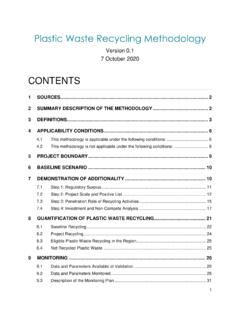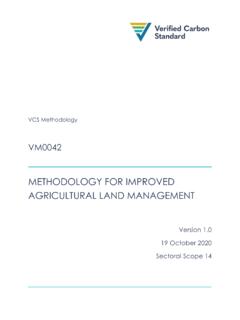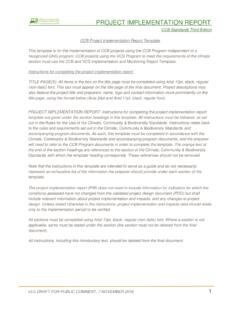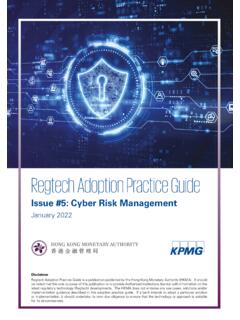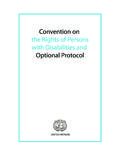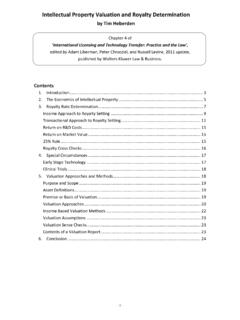Transcription of AFOLU Non-Permanence Risk Tool - Verra
1 AFOLU Non-Permanence Risk Tool19 September 1 ABOUT Verra Verra supports climate action and sustainable development through the development and management of standards, tools and programs that credibly, transparently and robustly assess environmental and social impacts, and drive funding for sustaining and scaling up these benefits. As a mission-driven, non-profit (NGO) organization, Verra works in any arena where we see a need for clear standards, a role for market-driven mechanisms and an opportunity to achieve environmental and social good. Verra manages a number of global standards frameworks designed to drive finance towards activities that mitigate climate change and promote sustainable development, including the Verified Carbon Standard (VCS) Program and its Jurisdictional and Nested REDD+ framework (JNR), the Verra California Offset Project Registry (OPR), the Climate, Community & Biodiversity (CCB) Standards and the Sustainable Development Verified Impact Standard (SD VISta).
2 Verra is also developing new standards frameworks, including LandScale, which will promote and measure sustainability outcomes across landscapes. Finally, Verra is one of the implementing partners of the Initiative for Climate Action Transparency (ICAT), which helps countries assess the impacts of their climate actions and supports greater transparency, effectiveness, trust and ambition in climate policies worldwide. Intellectual Property Rights, Copyright and Disclaimer This document contains materials, the copyright and other intellectual property rights in which are vested in Verra or which appear with the consent of the copyright owner. These materials are made available for you to review and to copy for the use (the Authorized Use ) of your establishment or operation of a project or program under the VCS Program (the Authorized Use ). Except for the Authorized Use, all commercial use of this document is prohibited.
3 You are not permitted to view, download, modify, copy, distribute, transmit, store, reproduce or otherwise use, publish, license, transfer, sell or create derivative works (in whatever format) from this document or any information obtained from this document otherwise than for the Authorized Use or for personal, academic or other non-commercial purposes. All copyright and other proprietary notices contained in this document must be retained on any copy that you make. All other rights of the copyright owner not expressly dealt with above are reserved. No representation, warranty or guarantee express or implied is made in this document. No representation, warranty or guarantee express or implied is made that the information provided is accurate, current or complete. Whilst care is taken in the collection and provision of this information, Verra and its officers, employees, agents, advisers and sponsors will not be liable for any errors, omissions, misstatements or mistakes in any information or damages resulting from the use of this information or any decision made or action taken in reliance on this information.
4 CONTENTS 1 INTRODUCTION AND SCOPE .. 1 Scope .. 1 2 RISK ANALYSIS AND BUFFER DETERMINATION .. 2 Step 1: Risk Analysis .. 2 Internal risks .. 3 External risks .. 9 Natural risks .. 13 Step 2: Overall Non-Permanence Risk Rating and Buffer Determination .. 16 APPENDIX 1: DOCUMENT HISTORY .. 18 1 Introduction and Scope 1 1 INTRODUCTION AND SCOPE This tool provides the procedures for conducting the Non-Permanence risk analysis and buffer determination required for Agriculture Forestry and Other Land Use ( AFOLU ) projects. The tool sets out the requirements for project proponents, implementing partners and validation/verification bodies to assess risk and determine the appropriate risk rating. The first version of the tool was developed by the VCS AFOLU Advisory Group in 2007 and 2008, which was composed of working groups of leading experts in each of the AFOLU project categories, and involved an extensive peer review process.
5 In 2010, as part of VCS Program Version 3, the tool was revised and put out to public stakeholder consultation. After considerable public input and with oversight from the VCS AFOLU Steering Committee, the tool was revised by Verra . More than 25 independent reviewers, including preeminent risk experts, investors, NGO representatives and project developers, supported these efforts and provided detailed feedback during the evolution of the tool. This document shall be updated from time-to-time and readers should ensure that they are using the most current version of the document. Scope This document sets out the procedures for conducting the Non-Permanence risk analysis to determine the Non-Permanence risk rating ( risk rating ), which shall be used to determine the number of buffer credits that an AFOLU project shall deposit into the AFOLU pooled buffer account (the procedure for deposit of buffer credits is set out in the VCS Program document Registration and Issuance Process).
6 Risk ratings are based on an assessment of risk factors which are added together to determine the total risk rating, as set out in Section 2. This document and the AFOLU pooled buffer account are subject to periodic reconciliation and revision based on a review of existing AFOLU verification reports and an assessment of project performance, as set out in the VCS Program Guide. In addition to the requirements set out in this document, AFOLU projects shall comply with all applicable VCS Program rules and requirements. Project proponents shall clearly document and substantiate the risk analysis covering each risk factor applicable to the project. During the analysis, the validation/verification body shall evaluate the risk assessment undertaken by the project proponent and assess all data, rationales, assumptions, justifications and documentation provided by the project proponent to support the Non-Permanence risk rating.
7 Non-Permanence risk analysis only needs to be applied to GHG removals or avoided emissions through carbon sinks. Project activities generating emissions reductions of N2O, CH4 or fossil-derived CO2 are not subject to buffer withholding, since these GHG benefits cannot be reversed. 2 Risk Analysis and Buffer Determination 2 2 RISK ANALYSIS AND BUFFER DETERMINATION Step 1: Risk Analysis The potential transient and permanent losses in carbon stocks shall be assessed over a period of 100 years and be based on the conditions present and the information available at the time of the risk analysis, unless otherwise specified in Sections to , to determine the appropriate risk rating. For example, projects with a project start date in the past, or projects analyzing risk at a subsequent verification event shall assess the potential transient and permanent losses for the next 100 years based on the conditions present and available at the time of risk analysis.
8 The risk analysis shall be conducted as follows: 1) Risk factors are classified into three categories: internal risks , external risks and natural risks , and further into sub-categories such as project management , financial viability and community engagement. The project shall be evaluated against each of the risk factors in each category and sub-category as set out in Sections (internal risks ), (external risks ) and (natural risks ), assigned a risk score for each risk factor, and shall follow the calculation formulas in each table to determine the risk rating for the sub-category and category. 2) Where applicable, and where the project proponent demonstrates that related mitigation activities will be (at validation) or are being (at verification) applied, the risk rating for the sub-category will be reduced, as determined in Sections to 3) As set out in Sections to , some sub-category tables allow the sub-category risk rating to be a number lower than zero, specifically where mitigation activities in the sub-category have the potential to reduce risks in other sub-categories.
9 Where risk mitigation synergies do not exist, the tables set a minimum rating of zero, even in cases where the calculation would otherwise determine a rating lower than zero. 4) The total risk rating for each category (internal, external and natural) shall be determined by summing the ratings for each sub-category in the category. While some sub-categories may have negative values, the total rating for any category may not be less than zero. 5) Where a project is assessed as Fail for any risk factor, the project shall fail the entire risk analysis. Where the overall risk rating, or the summed risk rating for each category is unacceptably high, as set out in Section , the project shall fail the entire risk analysis. Where a project fails the risk assessment, it is not eligible for crediting until such time as 2 Risk Analysis and Buffer Determination 3 the project has adequately addressed the risk to the extent it would no longer be assessed as Fail.
10 6) An overall risk rating percentage shall be determined based on the ratings from each risk category as set out in Section Where risks are relevant to only a portion of the project geographic area, the geographic area may be divided. Where a project is divided into more than one geographic area for the purpose of risk analysis, a single overall risk rating shall be determined for each geographic area and the project s monitoring and verification reports shall list the overall risk rating for each area and the corresponding net change in the project s carbon stocks in the same area. Internal risks Project management (PM) shall be assessed using Table 1, noting the following: 1) Each project management risk factor set out in Table 1 shall be assessed. Where a risk factor does not apply to the project, the score shall be zero for such factor. 2) management teams are those responsible for day-to-day project management and the implementation of project activities.

